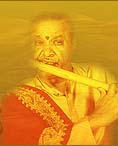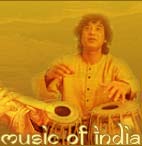Tambura is an Indian music instrument, which is known by the name of Tanpura in North India. It is unfretted and round-bodied, with a hollow neck and four or five (rarely six) wire strings. The strings of the Tambura are plucked one after another in a standard pattern, in order to create a tonic resonance field in Hindustani classical music. The instrument comes in different sizes, with the larger ones known as the 'males', while the smaller ones known as 'females'. The male Tambura has an open string, which is approximately one meter in length. On the other hand, the string of a female Tanpura is only three-fourth of an inch. The standard tuning of a Tanpura is 5-8-8-1 (sol do' do' do). In Indian sargam, it comes out to be PA sasa SA. In the five stringed tambura, the seventh or NI (natural minor or major 7th) is added with the music coming out as PA-NI-sa-sa-SA (5-7-8-8-1) or MA-NI-sa-sa-SA (4-7-8-8-1). The principle of jivari, which produces rich buzzing sound, is applied in order to attain the overtone-rich sound. Read on to get complete information on this amazing instrument, Tambura.
History
Etymology suggests that Tambura is derived from two words, 'tana' referring to musical phrase and 'pura' meaning complete. However, musicians believe that Tambura is the modified version of Veena, a musical instrument that has been in existence in Indian tradition since ancient times. We have seen Goddess Saraswati with a Veena in her hand. Even Rig Veda, one of the oldest surviving manuscripts has mentioned Veena in it. Thus, we can say that Tambura might have been derived from Veena and it resembles Veena too in many ways. Also, the fact that any string instrument was known as Veena could also suggest that maybe what we know as Tambura today had been called Veena some time back!
Types
The musical instrument of Tambura is designed in the following three types:
Miraj Style: The Miraj style is the most popular style of Tambura for the Hindustani music performers. It is three to five feet in length and has a well-rounded resonator plate (tabali). The neck is straight and hollow and it is fixed, along with the tabli, to the round lower chamber, which is made up of gourd (tumba).
Tanjore Style: The Tanjore style of Tanpura is famous in the southern states of India and is preferred by the Carnatic music performers. It is also three to five feet in length. However, its lower chamber is not made of gourd. Rather, it is spherical in shape and is hollowed out of a solid block of wood. The neck is smaller in diameter as compared to that of the Miraj style Tanpura.
Tamburi Style: The Tamburi style has gained popularity in the recent past, owing to its small size and portability. This Tambura is two to three feet long and has a shallow resonator. The tabali is slightly curved and there are four to six strings. The small five-string Tamburi is tuned to the higher octave and is preferred by artists for solo-performances.
Occasions
Tambura is usually played in classical musical concerts and festivals. It is also accompanied as an instrument for many songs. Tambura has a unique sound quality and hence can be combined with other instruments to create music.
Famous Tambura Players
Gowrishankar Gurusawmy, Soman Pillai, Prasanna Athele, Nellai Krishnan, Indira Sheshadri and Helen Francis are some of the famous tambura players that have given the instrument a worldwide recognition.






